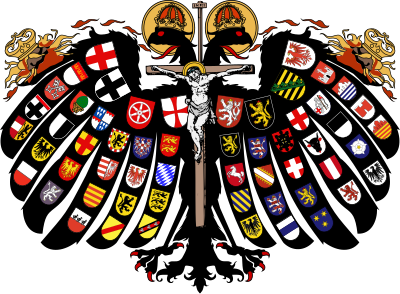
Search
Quaternion Eagle

The Quaternion Eagle (German: Quaternionenadler; Italian: Aquila Quaternione), also known as the Imperial Quaternion Eagle (German: Quaternionen-Reichsadler) or simply Imperial Eagle (German: Reichsadler), was an informal coat of arms of the Holy Roman Empire.
Introduced around 1510 by Hans Burgkmair, the Quaternion Eagle mixed two pre-existing concepts: the Imperial Quaternions and the Imperial Eagle (double-headed eagle).
History
Background
The so-called imperial quaternions (German: Quaternionen der Reichsverfassung, lit. 'quaternions of the imperial constitution'; from Latin: quaterniō, lit. 'group of four soldiers') were a conventional representation of the Imperial States of the Holy Roman Empire which first became current in the 15th century and was extremely popular during the 16th century.
Apart from the highest tiers of the emperor, kings, prince-bishops and the prince electors, the estates are represented in groups of four. The number of quaternions was usually ten, in descending order of precedence:
- Dukes (Duces),
- Margraves (Marchiones),
- Landgraves (Comites Provinciales),
- Burggraves (Comites Castrenses),
- Counts (Comites),
- Knights (Milites),
- Noblemen (Liberi),
- Cities (Metropoles),
- Villages (Villae),
- Peasants (Rustici).
The list could be shortened or expanded, by the mid-16th century to as many as 45.
It is likely that this system was first introduced under Emperor Sigismund, who is assumed to have commissioned the frescoes in Frankfurt city hall in 1414.
As has been noted from an early time, this representation of the "imperial constitution" does not in fact represent the actual constitution of the Holy Roman Empire, as some imperial cities appear as "villages" or even "peasants" and the Burggrave of Stromburg was an unknown entity even at the time. The representation of imperial subjects is also far from complete. The "imperial quaternions" are, rather, a more or less random selection intended to represent pars pro toto the structure of the imperial constitution.
Coat of the Empire
Over its long history, the Holy Roman Empire used many different heraldic forms, representing its numerous internal divisions. One rendition of the coat of the empire was the Quaternion Eagle, printed by David de Negker of Augsburg after a 1510 woodcut by Hans Burgkmair.
Named after the imperial quaternions, it showed a selection of 56 shields of various Imperial States in groups of four on the feathers of a double-headed eagle (the imperial eagle's remiges), supporting, in place of a shield, Christ on the Cross.
The top shields were those of the Prince Electors and the titular Prefect of Rome, being divided into two horizontal quaternions:
- the ecclesiastical: Trier, Cologne, Mainz and the Prefect of Rome on the right wing;
- the secular: Bohemia, Palatinate, Saxony and Brandenburg on the left.
Twelve vertical quaternions were shown under them, as follows — eight dukes being divided into two quaternions called "pillars" and "vicars", respectively:
The depiction also appeared on the Imperial Eagle beaker.
Imperial Eagle beaker
See also
- Coats of arms of the Holy Roman Empire
- Reichsadler
- Imperial Eagle
- Imperial Quaternions
Notes and references
Notes
References
Bibliography
- Panvinio, Onofrio (1558). De Comitiis Imperatoriis (in Latin). Basel.
- Goldast von Haiminsfeld, Melchior (1607). Constitutiones imperiales (in Latin). Frankfurt.
- Goldast von Haiminsfeld, Melchior (1612). Monarchia sacri Romani imperii (in Latin). Hanover & Frankfurt.
- Knorr von Rosenroth, Christian (1672). Anführung zur Teutschen Staats-Kunst [Introduction to the German State Art] (in German). Hofmann. Retrieved 4 November 2022 – via Google Books.
- Spener, Jacob Carl [in German] (1723). Teutsches ivs pvblicvm; oder, des Heil. Römisch-Teutschen Reichs vollständige Staats-Rechts-Lehre [German ivs pvblicvm; or, complete state-legal doctrine of the Holy Roman-German Empire] (in German). Vol. 1. George Marcus Knoche. Retrieved 4 November 2022 – via Google Books.
- Legband, Hans (1905). Zu den Quaternionen der Reichsverfassung [On the Quaternions of the Imperial Constitution] (in German). pp. 495–498.
{{cite book}}:|work=ignored (help) - Bund, Konrad (1987). Findbuch der Epitaphienbücher (1238)–1928 und der Wappenbücher (1190)–1801 [Inventory of the epitaph books (1238)–1928 and the heraldic books (1190)–1801] (in German). Kramer. ISBN 3782903315.
- Schubert, Ernst (1993). Die Quaternionen [The Quaternions] (in German). pp. 1–63.
{{cite book}}:|work=ignored (help) - Ocker, Christopher (2018). "The Imperial Quaternion Eagle (Augsburg, c. 1510)". Luther, Conflict, and Christendom. Cambridge University Press. pp. IX, 101–122. doi:10.1017/9781108178624. ISBN 9781108178624. S2CID 165918623. Retrieved 4 November 2022.
- Rödel, Volker (2018). Kaiser Maximilians Westreich und der Quaternionen-Reichsadler [Emperor Maximilian's Western Empire and the Imperial Quaternion Eagle] (in German). German Historical Institute Paris. doi:10.11588/fr.2018.0.70110. Retrieved 4 November 2022 – via Max Weber Foundation.
External links
- "Quaternion Eagle of the Holy Roman Empire". World History Encyclopedia. 22 March 2021. Retrieved 4 November 2022.
Text submitted to CC-BY-SA license. Source: Quaternion Eagle by Wikipedia (Historical)
Owlapps.net - since 2012 - Les chouettes applications du hibou


